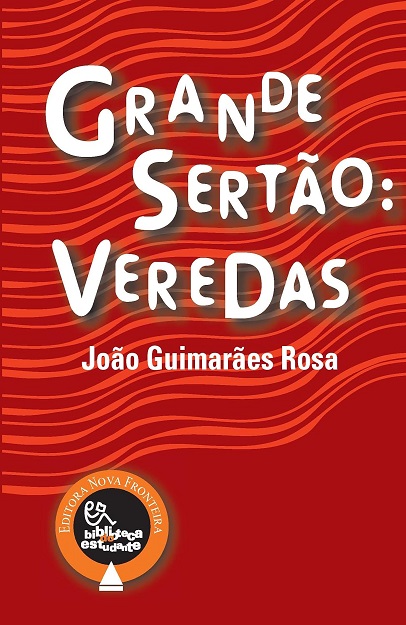“O senhor sabe: sertão é onde manda quem é forte, com as astúcias. Deus mesmo, quando vier, que venha armado!”. Assim, Riobaldo, o narrador-protagonista cujo relato dá corpo a Grande Sertão: Veredas, resume os dois grandes temas dessa grande obra da literatura brasileira, merecedora de toda atenção.
Um é o sertão, região inóspita que ocupa grande parte da zona interiorana do nordeste brasileiro, mais parte dos estados de Minas Gerais e Goiás. Seus habitantes, os sertanejos, espremiam a subsistência com um pouco de agricultura e reses magras, quando não recorriam à força para tomar dos outros aquilo de que necessitavam. No primeiro quartel do século passado, o sertão era uma zona sem lei, minto, onde lei era quem se mostrava mais forte, fossem os ocupantes das terras quase estéreis, passantes de mãos a mãos armadas, sangrentas, astutas, fossem os invasores, agentes do governo, polícias, milicianos, soldados, também de mãos armadas e sangrentas e astutas, desejosas não somente das terras, como da ordem que pretendiam estabelecer, nacional, do governo, e local, das oligarquias a serviço do governo.
O outro é Deus, a instância inevitável de um Brasil profundamente cristão, malgrado as reminiscências fazerem Riobaldo mencionar com ainda mais frequência o “Tal”, o “Cujo”, o “Não-se-diga” – o Diabo – uma força com quem não se negou, em momentos decisivos, a buscar uma relação. Porém é Deus a força maior, cuja onipresença ausente exerce fascínio sobre um perplexo e perdido Riobaldo, não menos por contradizer muito do que testemunhou em seu passado… até que lhe chega a velhice “despoderosa”, das azias e reumatismos, com um tipo de serenidade, a do que não poderia ter sido diferente de como foi. Tudo faria sentido, em seu tempo, mesmo deixando uma amargura abrandada, abrandada pela insensibilidade de quem foi criado homem na violência e pela violência.
Num imenso monólogo inconsútil, Riobaldo conta a longa história de sua existência meandrosa a um anônimo visitante, presumivelmente vindo da cidade, a quem roga que permaneça uns dias em sua fazenda e sacie a ânsia de ser ouvido, sentida por alguém que, como o protagonista, viveu demais. O relato tem o sotaque de um sertanejo quase bem letrado, com um fino senso da importância do que está ou se ouve dos livros, donde o interesse que causa no leitor a mistura de registros da caudalosa prosa caipira, cujo movimento vigoroso, de montante a jusante, ressaca, como se espuma fossem, expressões e referências e temáticas eruditas, que estão ali para assinalar a significância universal de uma realidade de qualquer maneira tão particular. As palavras sucedem-se, criando torvelinhos de memórias, abrindo braços d’água que se prolongam em episódios memoráveis, os quais, no conjunto, registram o espraiar sinuoso em direção ao presente. O discurso do narrador flui e reflui segundo os caprichos da memória e dos ensejos da conversa com um interlocutor a quem permanecemos surdos: o som do rio baldo encobre tudo.
Ao longo da leitura, reconstituímos que o narrador começara como um caso excepcional em seu meio, recebendo os rudimentos da educação que o levariam a se tornar tutor de um latifundiário. Contra as melhores expectativas, Riobaldo ingressa na tropa de seu patrono que, enquanto braço privado do governo, pretendia consolidar seu domínio sobre a insurgência dos jagunços. Estes últimos, bandos de bandidos aos olhos dos supostos bons, faziam as suas leis com suas armas, conforme o código ético próprio do sertanejo, fundado na “valentia”, que significa não temer a morte e ter coragem de matar, mesmo quando desnecessário. Numa ironia do destino, o protagonista vira um trânsfuga, ingressando num desses bandos e abraçando o seu estilo de vida. Riobaldo o Tatarana o jagunço. Do seu ponto de vista, nunca parece haver uma diferença qualitativa entre quaisquer dessas facções, pelo que a condição essencial do homem, a “ruindade”, é de confronto cotidiano com a brutalização decorrente do simples estar ali, presente no dia a dia, exposto ao perigo dos outros, expondo-os ao próprio perigo. Apesar de toda hesitação, o narrador trilha esse caminho até às últimas consequências: Depois de firmar um pacto com “Ele, o Dado, o Danado” para obter poderes sobrenaturais, depois de se tornar Riobaldo o Urutu-branco o líder de sua própria quadrilha, depois de vencer a guerra definitiva contra os odiosos “judas”…
Até mais do que o enlevo do enredo, um dos encantos dessa estória é o de que, embora aja como um jagunço, melhor, embora seja, em atos e pensamentos, um jagunço, Riobaldo não deixa de nutrir afetos puros por outrem. Neste caso, por seu mais fiel amigo e companheiro: Diadorim. O afeto, fundado numa estranha atração, teimosamente representa Diadorim como um jovem delicado e feminino sob toda a sua valentia e familiaridade com a violência. Tais sensações, difíceis de aceitar para um sertanejo, causam momentos de vergonha e de reflexão sobre a razão de ser do amor, especialmente quando o termo não pode ser aplicado, quanto mais admitido. O jagunço e sua quadrilha mantêm uma relação de família estendida e é nesse nível em que a moralidade tem força absoluta – donde a relação de irmandade entre Riobaldo e Diadorim ter de ser, ao mesmo tempo em que não pode se tornar algo mais. Nada obstante, a tensão emocional entre ambos cresce até um ponto em que o protagonista se decide a dar o “topázio de Araçuaí”, um presente de “noivado”, para seu irmão de armas. Diadorim deixa a impressão de tergiversar e Riobaldo se compromete com a sua futura esposa, aparentemente livre do sentimento de culpa, mas com uma angústia profunda, do confronto com o seu coração.
O dilema surge cedo no romance e resolve-se, tragicamente, no clímax final da obra, por meio de uma anagnórise inesquecível. Toda existência culmina numa sabedoria. Para surpresa de Riobaldo, a dele culminaria numa felicidade possível, em que Deus prevaleceu sobre o demônio, a experiência preencheu o vazio, e o amor… “bem-querer de minha mulher foi que me auxiliou, rezas dela, graças. Amor vem de amor. Digo. Em Diadorim, penso também – mas Diadorim é a minha neblina...”




